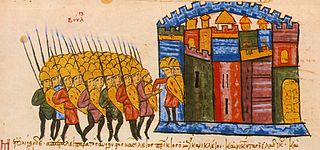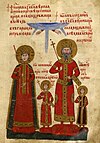Preslav Literary School

A column remaining from the Throne Hall at Preslav
The Preslav Literary School (Bulgarian: Преславска книжовна школа), also known as the Pliska Literary School, was the first literary school in the medieval Bulgarian Empire. It was established by Boris I in 885 or 886 in Bulgaria's capital, Pliska. In 893, Simeon I moved the seat of the school from Pliska to the new capital, Preslav. Preslav was captured and burnt by the Byzantine Emperor John I Tzimisces in the year 972 in the aftermath of Sviatoslav's invasion of Bulgaria.
Contents
1 History
2 See also
3 References
4 External links
History

Old Bulgarian Alphabet
The Preslav Literary School was the most important literary and cultural centre of the Bulgarian Empire and of all Slavs. A number of prominent Bulgarian writers and scholars worked at the school, including Naum of Preslav until 893; Constantine of Preslav; Joan Ekzarh (also transcr. John the Exarch); and Chernorizets Hrabar, among others. The school was also a centre of translation, mostly of Byzantine authors. Finally, it was a centre of poetry, of painting, and of painted ceramics.
The school developed the Cyrillic script:
Unlike the Churchmen in Ohrid, Preslav scholars were much more dependent upon Greek models and quickly abandoned the Glagolitic scripts in favor of an adaptation of the Greek uncial to the needs of Slavic, which is now known as the Cyrillic alphabet.[1]
The earliest datable Cyrillic inscriptions have been found in the area of Preslav. They have been found in the medieval city itself, and at nearby Patleina Monastery, both in present-day Shumen Province; in Krepcha, which is in present-day Targovishte Province; and in Ravna, present-day Varna Province.
In Ravna, an unusually large number of inscriptions in the form of 330 instances of graffiti were found, written in Old Bulgarian and in other languages. Many were written by lay people, and some are obscene. Some were written in both Cyrillic and other alphabets,[2] prompting Umberto Eco to label Ravna "a 10th-century language laboratory". Another impressive body of 10th-century Cyrillic inscriptions has been found in the form of a number of leaden pendants, the bulk of which have also been found in an area in northeastern Bulgaria between Preslav and Varna but also extending north into present-day southeastern Romania.[3]
The Preslav School scriptoria where works were created were scattered over much of present-day northeastern Bulgaria, including churches and monasteries at Preslav, where the remains of 25 churches have been found. Other locations include Pliska, Patleina, Khan Krum, and Chernoglavtsi which are all in present-day Shumen Province; Ravna, in Varna Province; and finally Murfatlar in Dobruja, now in Romania.[4][5]
See also
- Cyrillic script
- Early Cyrillic alphabet
- First Bulgarian Empire
- History of Bulgaria
- Ohrid Literary School
- Relationship of Cyrillic and Glagolitic scripts
References
^ Curta, Florin (18 September 2006). Southeastern Europe in the Middle Ages, 500–1250 (Cambridge Medieval Textbooks). Cambridge University Press. pp. 221–222..mw-parser-output cite.citation{font-style:inherit}.mw-parser-output .citation q{quotes:"""""""'""'"}.mw-parser-output .citation .cs1-lock-free a{background:url("//upload.wikimedia.org/wikipedia/commons/thumb/6/65/Lock-green.svg/9px-Lock-green.svg.png")no-repeat;background-position:right .1em center}.mw-parser-output .citation .cs1-lock-limited a,.mw-parser-output .citation .cs1-lock-registration a{background:url("//upload.wikimedia.org/wikipedia/commons/thumb/d/d6/Lock-gray-alt-2.svg/9px-Lock-gray-alt-2.svg.png")no-repeat;background-position:right .1em center}.mw-parser-output .citation .cs1-lock-subscription a{background:url("//upload.wikimedia.org/wikipedia/commons/thumb/a/aa/Lock-red-alt-2.svg/9px-Lock-red-alt-2.svg.png")no-repeat;background-position:right .1em center}.mw-parser-output .cs1-subscription,.mw-parser-output .cs1-registration{color:#555}.mw-parser-output .cs1-subscription span,.mw-parser-output .cs1-registration span{border-bottom:1px dotted;cursor:help}.mw-parser-output .cs1-ws-icon a{background:url("//upload.wikimedia.org/wikipedia/commons/thumb/4/4c/Wikisource-logo.svg/12px-Wikisource-logo.svg.png")no-repeat;background-position:right .1em center}.mw-parser-output code.cs1-code{color:inherit;background:inherit;border:inherit;padding:inherit}.mw-parser-output .cs1-hidden-error{display:none;font-size:100%}.mw-parser-output .cs1-visible-error{font-size:100%}.mw-parser-output .cs1-maint{display:none;color:#33aa33;margin-left:0.3em}.mw-parser-output .cs1-subscription,.mw-parser-output .cs1-registration,.mw-parser-output .cs1-format{font-size:95%}.mw-parser-output .cs1-kern-left,.mw-parser-output .cs1-kern-wl-left{padding-left:0.2em}.mw-parser-output .cs1-kern-right,.mw-parser-output .cs1-kern-wl-right{padding-right:0.2em}
^ Silent Communication: Graffiti from the Monastery of Ravna, Bulgaria. Studien Dokumentationen. Mitteilungen der ANISA. Verein für die Erforschung und Erhaltung der Altertümer, im speziellen der Felsbilder in den österreichischen Alpen (Verein ANISA: Grömbing, 1996) 17. Jahrgang/Heft 1, 57–78.
^ Curta, Florin, Southeastern Europe in the Middle Ages, 500–1250 (Cambridge Medieval Textbooks), Cambridge University Press (September 18, 2006), p. 222.
^ "The scriptorium of the Ravna monastery: once again on the decoration of the Old Bulgarian manuscripts 9th–10th c." In: Medieval Christian Europe: East and West. Traditions, Values, Communications. Eds. Gjuzelev, V. and Miltenova, A. (Sofia: Gutenberg Publishing House, 2002), 719–726 (with K. Popkonstantinov)
^ Popkonstantinov, Kazimir, Die Inschriften des Felsklosters Murfatlar. In: Die slawischen Sprachen 10, 1986, S. 77–106.
External links
- Nikolov, A. The Perception of the Bulgarian Past in the Court of Preslav around 900 AD. - In: State and Church: Studies in Medieval Bulgaria and Byzantium. Ed. by V. Gjuzelev and K. Petkov. American Research Center in Sofia: Sofia, 2011, 157-171
Topics on the Bulgarian Empire | |||
|---|---|---|---|
| State | Military | Culture | |
Origin
States
De facto independent Bulgarian states from the Second Empire
Administration
Important rulers First Bulgarian Empire Asparukh • Tervel • Krum • Omurtag • Boris I • Simeon I • Peter I • Samuel Second Bulgarian Empire Ivan Asen I • Kaloyan • Ivan Asen II • Konstantin Tih • Michael Shishman • Ivan Alexander Economy
|
Conflicts
Major battles First Bulgarian Empire Battle of Ongal • Siege of Constantinople • Battle of Marcellae • Battle of Pliska • Battle of Southern Buh • Battle of Achelous • Battle of the Gates of Trajan • Battle of Kleidion • Battle of Dyrrhachium Second Bulgarian Empire Battle of Tryavna • Battle of Adrianople • Battle of Klokotnitsa • Battle of Skafida • Battle of Velbazhd • Battle of Rusokastro • Battle of Chernomen • Siege of Tarnovo • Battle of Nicopolis Major uprisings
 | Literature 
Prominent writers and scholars: Art and architecture
Famous examples: Religion 
| |


